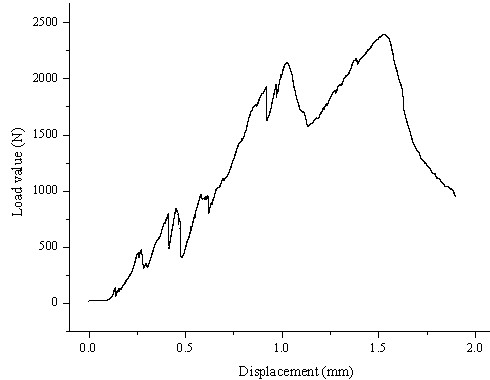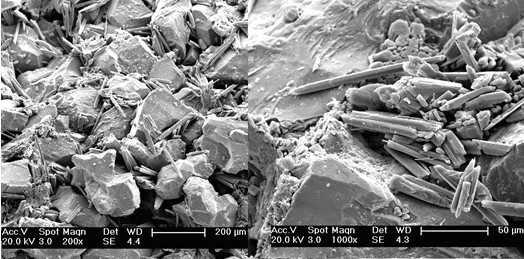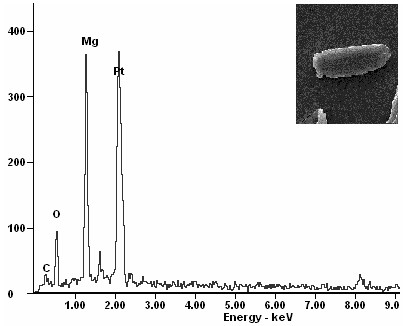Microbial gelled material and method for forming magnesite by using same to glue sand grains
A technology of microbial glue and magnesite, which is applied in the field of magnesite cemented sand particles, can solve the problems of polluting the environment and destroying the ecology, and achieves the effect of clean environment and low cost
- Summary
- Abstract
- Description
- Claims
- Application Information
AI Technical Summary
Problems solved by technology
Method used
Image
Examples
Embodiment 1
[0029] (1) Weigh 5g of peptone, 3g of beef extract and 1000ml of distilled water to prepare a medium, adjust the pH to 7.0, sterilize and dry, inoculate the prepared medium with Bacillus pasteurianus, and shake at 30°C Cultivate with an oscillation frequency of 170r / min, and cultivate for 24h;
[0030] (2) Configure the concentration of urea solution to be 2 mol L -1 , MgCl 2 ·6H 2 O solution concentration is 2mol L -1 mixed solution;
[0031] (3) Weigh 56.56g of sand with a particle size below 0.15mm and 23.44g of sand with a particle size of 0.15~0.3mm, and put them into a 60ml disposable syringe in three times, and tap the outside of the syringe during each loading process to The loaded sand is densely packed, and the tight void ratio is 43.1%;
[0032] (4) Connect the bottom of the syringe with a peristaltic pump, inject the bacterial solution at a rate of 5ml / min, let it stand for 2 hours after filling, and inject the mixed solution at a rate of 15ml / min after the ba...
Embodiment 2
[0037] (1) Weigh 4g of peptone, 4g of beef extract and 1000ml of distilled water to prepare a medium, adjust the pH to 6.0, sterilize and dry, inoculate Bacillus pasteurianus into the prepared medium, and shake at 30°C Cultivate with an oscillation frequency of 170r / min, and cultivate for 16h;
[0038] (2) Configure the concentration of urea solution to be 3 mol L -1 , MgCl 2 ·6H 2 O solution concentration is 1mol L -1 mixed solution;
[0039] (3) Weigh 63.63g of sand with a particle size below 0.15mm and 26.37g of sand with a particle size of 0.15~0.3mm, and put them into a 60ml disposable syringe in three times, and tap the outside of the syringe during each loading process to The loaded sand is densely packed, and the tight void ratio is 42.8%;
[0040] (4) Connect the bottom of the syringe with a peristaltic pump, inject the bacterial solution at a rate of 4ml / min, let it stand for 1 hour after filling, and inject the mixed solution at a rate of 10ml / min after the bac...
Embodiment 3
[0042] (1) Weigh 6g of peptone, 4g of beef extract and 1000ml of distilled water to prepare a medium, adjust the pH to 8.0, sterilize and dry, inoculate the prepared medium with Bacillus pasteurianus, and shake at 30°C Cultivate with an oscillation frequency of 170r / min, and cultivate for 24h;
[0043] (2) Configure the concentration of urea solution to be 1 mol L -1 , MgCl 2 ·6H 2 O solution concentration is 3mol L -1 mixed solution;
[0044] (3) Weigh 49.49g of sand with a particle size below 0.15mm and 20.51g of sand with a particle size of 0.15~0.3mm, and put them into a 60ml disposable syringe in three times, and tap the outside of the syringe during each loading process to The loaded sand is densely packed, and the tight void ratio is 42.6%;
[0045] (4) Connect the bottom of the syringe with a peristaltic pump, inject the bacterial solution at a rate of 6ml / min, let it stand for 3 hours after filling, and inject the mixed solution at a rate of 20ml / min after the ba...
PUM
 Login to View More
Login to View More Abstract
Description
Claims
Application Information
 Login to View More
Login to View More - R&D
- Intellectual Property
- Life Sciences
- Materials
- Tech Scout
- Unparalleled Data Quality
- Higher Quality Content
- 60% Fewer Hallucinations
Browse by: Latest US Patents, China's latest patents, Technical Efficacy Thesaurus, Application Domain, Technology Topic, Popular Technical Reports.
© 2025 PatSnap. All rights reserved.Legal|Privacy policy|Modern Slavery Act Transparency Statement|Sitemap|About US| Contact US: help@patsnap.com



